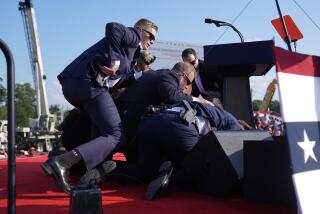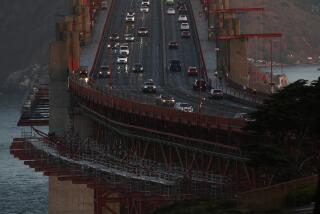Walkways to Put D.C. Mall Tourists at Safer Distance
- Share via
WASHINGTON — The ring of Jersey barriers that has surrounded the Washington Monument since 1998 would be replaced by walled, sunken walkways and visitors would enter the obelisk through a new underground tunnel under a security plan unanimously endorsed by the Commission of Fine Arts.
The proposal, the winning entry in a design contest sponsored by the National Park Service, has not received congressional funding, and Park Service officials said they do not have an estimate on what it would cost.
But John Parsons, the agency’s assistant regional director, said that since Sept. 11, installing a permanent security barrier at the monument has become a priority for the Interior Department and congressional budget writers. If the funding is in place soon, he said, construction could begin in August and be completed a year later. He said the Park Service is “hopeful we will get the construction money.”
Parsons said the Park Service is working with the same urgency to develop plans for new perimeters around the Jefferson and Lincoln memorials. He said the agency will submit a proposal next month to install specially designed metal posts near those landmarks.
The Jersey barriers around the Washington Monument were hastily erected as a temporary anti-terrorism measure after the bombings of the U.S. embassies in Kenya and Tanzania. Since then, the massive, concrete slabs in the heart of the Mall have drawn scorn from tourists, Washington residents and federal planners alike. But officials have been unable to agree on an alternative.
Members of the Fine Arts Commission said the plan, approved Thursday, meets security and design requirements. The plan was conceived by the Olin Partnership of Philadelphia.
Two 12-foot-wide sunken walkways, walled in stone, would loop around the monument. The walls and the paths’ three-foot drop would be enough to stop a vehicle trying to approach the monument, said Laurie Olin, principal of the firm. But the paths would not be visible from a distance because they would be cut into the hill on which the monument stands, Olin said. Pedestrians would be able to leave the walkway and go up to the base of the monument.
The makeshift visitor-screening facility recently added to the monument grounds would be removed. Instead, visitors would enter the Lodge, a nearby structure that is being used as a concession stand, and from there they would travel through a 400-foot tunnel to reach the monument.
Along the way, they would stop at a 20,000-square-foot underground visitor center that would contain skylights, restrooms, displays and a booth issuing free tickets to ride the elevator to the top of the monument. After being screened by U.S. Park Police, visitors would enter the elevator one floor below the current entrance.
The plan still needs the approval of the National Capital Planning Commission and the Historic Preservation Review Board.
More to Read
Sign up for Essential California
The most important California stories and recommendations in your inbox every morning.
You may occasionally receive promotional content from the Los Angeles Times.













